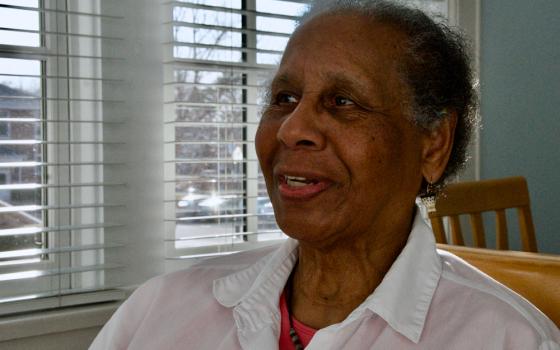
"The Raising of the Daughter of Jairus" (1873) by German artist Eduard Julius Friedrich Bendemann (Metropolitan Museum of Art)
I was reflecting on the Gospel story in Mark 5:21-43, contemplating how theological reflection could enhance the quality of care offered by global health services to protect and restore the health, well-being and dignity of the person.
A man approaches Jesus to tell him that his little girl is very sick and at the point of death. He is out of his mind with distress, falling on his knees and pleading with Jesus to come and lay his healing hands on the little girl. We do not know the little girl's name.
Jesus' eyes fill with tears at the father's distress; he reaches out to help him up and I imagine he says, We will go now to your daughter, we cannot wait, we must leave immediately. The man is so overcome with emotion that he is unsteady on his feet but ever so gently Jesus reaches out to help him up. They set off, but we do not know if they will reach the family home before sunset.
A warm breeze fills the air, bird song rings out and the vines in the fields are coming into blossom. Along the way, Jesus asks the father to tell him about his little girl: what her name is, how old she is, are there any brothers and sisters, who is caring for her now — her mother, a relative or a neighbor? Has the little girl had any treatment?
People who had come to listen to Jesus have been moved by the father's distress and they decided to follow Jesus. Some are praying; others are talking among themselves and speculating about what is going on.
The child is very sick and what father would not go to the ends of the earth to seek healing for a very sick child? Jesus gently reassures and comforts him and he begins to relax a little as they walk along.
In the crowd, a lady shuffles forward and touches Jesus' clothes. She is silently weeping and in great distress. No words issue forth from her lips. A few moments later, she straightens up, the pain that was etched across her face has been replaced with a deep inner peace.
Suddenly, Jesus cries out, "Who touched me?"
Silence. Then someone cackles: "Many people are here — anyone could have touched you! We all want to be near you."
Once more, Jesus' strong, gentle voice repeats, "Who touched me!"
Slowly, ever so slowly the lady emerges from the crowd and approaches Jesus. I imagine her saying:
It was me, sir, I touched you. I have had this awful painful bleeding for many years. I am exhausted and worn out with pain. I have been to Jerusalem and many other places but all the doctors, faith healers and herbalists tell me that there is nothing that they can do for me. I will have to live with my complaint until it resolves itself. We have no children; my husband has threatened to leave me and we have been plunged into poverty because of my illness. I am heartbroken and don't know what to do. I cry myself to sleep, I feel so ashamed and so alone.
Jesus leans over, places his right hand gently on her right shoulder, and looks softly into her eyes and says, "Your faith has healed you. Go in peace."
She wipes her tears and silently walks away. Chatter resumes: Who is she? Who is this man? How can we have faith like this?
Advertisement
The journey continues. As they reach the man's family home, he becomes more anxious about his little girl, wondering: How is she now? I hope she is not any worse.
Suddenly, his servant appears to tell him that his little girl has just died. She opened her eyes, looked into the distance, smiled and then she was gone.
The father sobs uncontrollably; Jesus take him by the hand. He turns to the crowd and says, James, John and Peter, you come with me. The rest of you go home now. We must make haste to see this little girl.
Near the home, many people have gathered, men standing around in stony silence, women clinging to each other, weeping. The door is closed and the heart-wrenching cry of the mother could be heard in Jerusalem. The father leads Jesus into the home, moves forward and gently kisses his wife's cheek and they all go together to the little girl's bedside.
Jesus raises his eyes to heaven, takes the little girl's right hand in his, and prays. Looking directly at her parents, he says, "She is not dead, she is asleep." Glancing at parents and child Jesus say, "Talitha kum — little girl, get up."
To the amazement of her parents the little girl got out of bed and started to walk about. Sensitive to the needs of a growing child, Jesus asks her parents to give her something to eat. He pleads with them not to say anything about all that has taken place, and continues on his mission. Tears of anguish and desolation turned to joy in that home that day.
We can imagine that Jesus later sought out and visited the lady who had been healed. He listened to her life story, prayed with her and her husband and invited them to be his disciples. He may have asked her to begin a special ministry to women in distress so that many more could come to know the compassionate love of God. In joy and gratitude, she accepted his invitation so that the name of the most high God could be praised, honored and glorified forever.
Jesus entered a person-centered relationship with each person and revealed how uniquely special they are to God. He immediately responded to need and did not discriminate in any way; as he called them to fulness of life, the empowerment of the person was his mission: "I have come that you may have life and have it to the full" (John 10:10). All is for the glory of God. We too are invited to share in his mission of love and to be guided by him.






